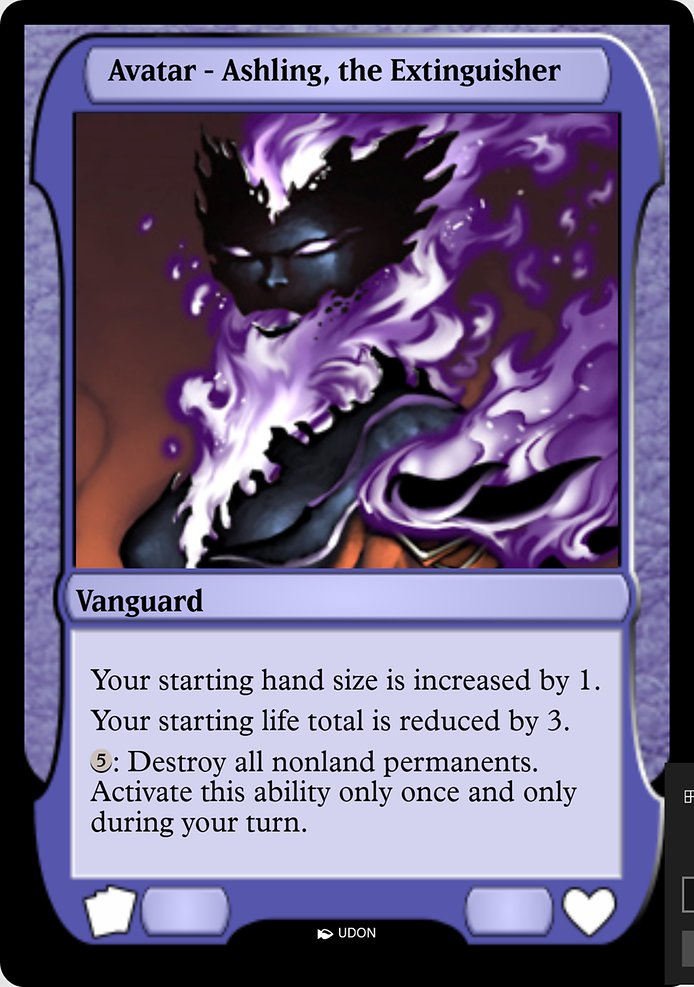
Image courtesy of Scryfall.com
Ashling, the Extinguisher Avatar: What makes this Vanguard a cult favorite
Magic players love a card that feels like a signature moment—the kind you tell stories about for years. Ashling, the Extinguisher Avatar is one such moment, tucked into MTGO’s Vanguard slot and beloved by a devoted subset of fans who relish big, dramatic plays. This is not your average mana curve. Ashling costs nothing to play, yet the real magic arrives when you pay five colorless mana to ignite a purge that reshapes the battlefield on your turn. Destroy all nonland permanents. Activate only once and only during your turn. It’s equal parts spectacle and strategy, a design that invites mischief, risk, and glorious chaos 🧙♂️🔥.
The card’s colorless identity—a rarity in a game known for color identities—lets it slot into unconventional decks that celebrate raw power without forcing a particular color strategy. Ashling’s Vanguard frame (a special MTGO-era print) reinforces that sense of digital collectibility and nostalgia. The text is blunt and efficient, like a dramatic cue card: you establish a clean slate, you stare down the consequences, and you live with the aftermath. The life modifier and hand modifier—life down by 3, hand up by 1—add a tasteful balance: you’re rewarded with a bigger hand just as the world burns around you. It’s design that rewards bold timing and calculated risk, a duality fans find irresistible 🧭⚔️.
- Unpredictable tempo: wiping the board on your own turn creates a dramatic swing that can reset a crowded table and tilt the game in your favor.
- Pure spectacle: a single, high-stakes activation becomes a memory you’ll retell—especially at MTGO events or casual nights where banter about “the ash” fills the air 🔥.
- Rarity and novelty: as a rare Vanguard card from a digital-only set, Ashling sits at the intersection of nostalgia and curiosity, a trophy for those who chase quirky corners of the MTG multiverse.
Conceptually, Ashling embodies a themed fantasy moment: extinguishing a world of permanents to start anew. That flavor locks in as fans debate how to time the play, what to sacrifice, and what the board would look like after the smoke clears. The “Extinguisher Avatar” name hints at a larger mythos—an avatar who wields apocalypse with ceremonial precision—making it a talking point in online chats, colorless-deck theory threads, and MTG lore roundups. The art by UDON and the Vanguard frame add a painterly, collector-friendly aura that keeps it relevant even as new sets flood the shelves 🎨🧙♂️.
Playstyle and deckbuilding: what Ashling unlocks
When you build around Ashling, you’re not chasing a standard removal engine; you’re designing around a dramatic, one-shot rite. The ability to destroy all nonland permanents is the ultimate reset button, effectively turning the table into a blank canvas where lands remain as the only permanent presence. That means you’ll lean into acceleration and mana efficiency so that you can commit to the five-mana activation at the right moment. It’s a test of patience and nerve—get the timing perfect, and you watch your opponents scramble while you rebuild from the ground up 🧙♂️⚡.
Because Ashling is colorless and mana-neutral, it lends itself to inventive, sandbox-style builds. You can pair it with effects that exploit the board state after a wipe—such as token drills, landfall themes, or other big-picture finishers that don’t rely on the battlefield existing in a traditional sense. The single-use clause turns each potential world-ending play into a memorable pinnacle, a moment players measure against the “Ashling moment” in their personal MTG story vaults 🔥⚔️.
Artwork, lore, and the collector’s allure
Art matters in Magic, and Ashling’s illustration by UDON carries a kinetic sense of flame and ash that mirrors the card’s destructive promise. The Vanguard frame—designed for MTGO avatars—gives Ashling a digital-first aura, a nod to the card’s origin in a community-driven, online-centric era. The rarity flag (rare) and the digital-only footprint amplify its mystique: it isn’t a staple in tournament tables, but it’s a badge of niche expertise—an emblem for players who went digging into MTGO’s archive to uncover long-lost or unusual prints. For collectors and lore-seekers, Ashling’s combination of text, art, and setting creates a compelling story arc: a rare, dramatic moment that lives on in memory and in digital galleries 📚💎.
From a play-history perspective, Ashling occupies a curious niche. It’s not a typical commander or standard-legal powerhouse, yet it embodies the joy of MTG’s “what-if” scenarios—the idea that a single, well-timed action can redefine the entire game. For many, that idea is what keeps the game feeling alive: a perpetual invitation to dream up wild board states and share those moments with friends and online communities 🎲🧙♂️.
Market chatter around Ashling in MTGO terms shows a small but devoted interest base. The card’s digital status and rarity translate into a collector’s pride more than mass-market price spikes, making it a coveted piece for those who chase oddities and the thrill of the online archive. If you ever stumble upon a foil version or a vivid print online, you’ll likely hear someone reminisce about “the ash” when the board goes up in flames and the room erupts in reactions 🔥💬.
For fans who love cross-media synergy, this is also a nice reminder of the broader MTG ecosystem—how a card can spark discussions about art, design choices, and the playful tension between risk and reward. Ashling isn’t just a card; it’s a mini-narrative you can bring to the table, a reason to lean into bold play, and a reminder that sometimes the most memorable MTG moments come from the most daring gambles 🧙♂️🎨.
Clear Silicone Phone Case Slim Profile Durable FlexibleMore from our network
- https://crypto-acolytes.xyz/blog/post/how-to-track-economic-trends-in-the-metaverse/
- https://blog.digital-vault.xyz/blog/post/luminous-blue-giant-beacon-from-dr3-data-refining-galactic-models-afar/
- https://blog.digital-vault.xyz/blog/post/how-voracious-wurm-art-elevates-gameplay-flavor/
- https://crypto-acolytes.xyz/blog/post/top-retro-multiplayer-racing-games-you-must-try/
- https://transparent-paper.shop/blog/blog/post/create-effective-banner-templates-for-small-businesses/